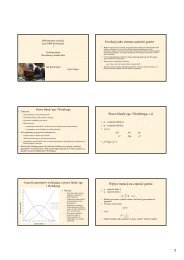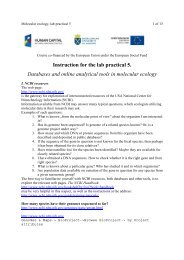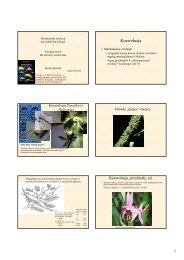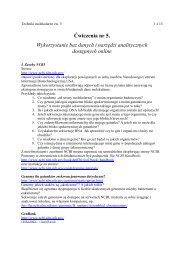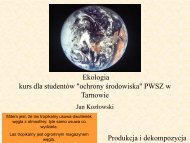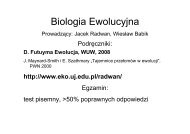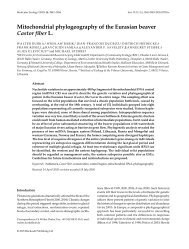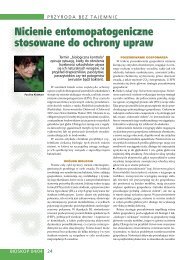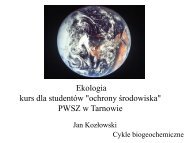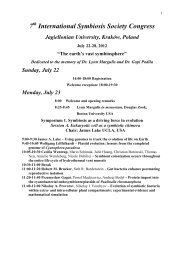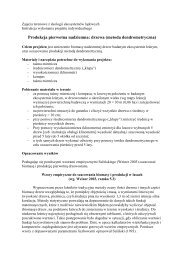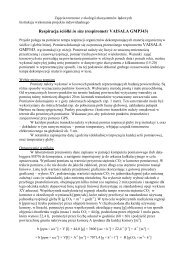Genetic variation
Genetic variation
Genetic variation
Create successful ePaper yourself
Turn your PDF publications into a flip-book with our unique Google optimized e-Paper software.
Conservation genetics of plants with<br />
special regard to gene flow within and<br />
among populations<br />
Walter Durka
Outline<br />
• Introduction<br />
• Population structure of Stipa pulcherrima<br />
• Pollen dispersal in Euphorbia palustris<br />
• Inbreeding depression in Juncus atratus<br />
• Landscape genetics of Geum urbanum<br />
• Conclusions<br />
Page 2
Objectives of molecular ecology<br />
„Molecular markers are routinely used in the measurement of<br />
• seed and pollen dispersal<br />
• the study of breeding systems<br />
• the assessment of genetic diversity between and within plant populations<br />
• the identification of species (viz. DNA barcoding)<br />
• the elucidation of phylogenetic relationships between plant species<br />
• the study of kinship<br />
• and the survey of phylogeographical patterns.“(Ouborg & Vriezen 2007)<br />
Page 3
Objectives of conservation genetics<br />
Conservation genetics<br />
What to protect ? <strong>Genetic</strong> issues<br />
Aim: conservation of total phylogenetic diversity in circumscribed conservation units<br />
• Species identification, delimitation, hybridisation: phylogeny<br />
• Conservation units, ESU: phylogeography<br />
• Local adaptation, e.g. use of local seed material<br />
How to protect ?<br />
Target: genetic <strong>variation</strong> is sufficient to maintain λ > 1<br />
• dispersal: gene flow, population structure, landscape context<br />
• Population level: level of genetic <strong>variation</strong>,<br />
• Individual level: breeding systems, inbreeding depression?<br />
• Ex situ conservation, captive breeding<br />
Page 4
Challenges for conservation remain<br />
• Land use<br />
• competition for space for energy crops -> habitat loss, fragmentation<br />
• intensification<br />
• Climate change<br />
• adapation<br />
• range contraction, range extension<br />
• Invasive species<br />
• competition<br />
• hybridisation<br />
Page 5
<strong>Genetic</strong> <strong>variation</strong><br />
Land use<br />
Landscape structure<br />
Census size<br />
Habitat<br />
quality<br />
Habitat<br />
connectivity<br />
Inbreeding<br />
depression<br />
Effective<br />
population size<br />
Outcrossing rate<br />
Fitness<br />
Inbreeding<br />
Drift<br />
Pollinators<br />
Seed<br />
dispersers<br />
Evolutionary<br />
potential<br />
<strong>Genetic</strong> <strong>variation</strong><br />
Selection<br />
Pollen<br />
dispersal<br />
Seed<br />
dispersal<br />
Local<br />
adaptation<br />
<strong>Genetic</strong><br />
differentiation<br />
Gene flow<br />
Migration<br />
Positive correlation<br />
Outbreeding<br />
depression<br />
Negative correlation<br />
Page 6<br />
Evolutionary<br />
units<br />
cf. Obourg et al. 2006
<strong>Genetic</strong> <strong>variation</strong><br />
Land use<br />
Landscape structure<br />
Census size<br />
Habitat<br />
quality<br />
Habitat<br />
connectivity<br />
Inbreeding<br />
depression<br />
Effective<br />
population size<br />
Outcrossing rate<br />
Fitness<br />
Inbreeding<br />
Drift<br />
Pollinators<br />
Seed<br />
dispersers<br />
Evolutionary<br />
potential<br />
<strong>Genetic</strong> <strong>variation</strong><br />
Selection<br />
Pollen<br />
dispersal<br />
Seed<br />
dispersal<br />
Local<br />
adaptation<br />
<strong>Genetic</strong><br />
differentiation<br />
Gene flow<br />
Migration<br />
Positive correlation<br />
Outbreeding<br />
depression<br />
Negative correlation<br />
Evolutionary<br />
units<br />
Page 7
Being a relict …<br />
Xerothermic dry grassland species are relicts of warmer postglacial periods<br />
• Fragmented and isolated<br />
• <strong>Genetic</strong> <strong>variation</strong> reduced due to bottlenecks?<br />
• Gene flow among populations ?<br />
Stipa pulcherrima<br />
• 20 populations á 10 indiv.<br />
• 148 AFLP loci<br />
• 75 polymorphic loci<br />
Page 8<br />
Nossol 2007 diploma thesis
<strong>Genetic</strong> <strong>variation</strong> in long-term fragmented<br />
isolated populations<br />
‣ extreme genetic uniformity within many<br />
populations<br />
‣ Mean % polymoprhic loci = 4.6<br />
‣ H j<br />
= 0.016<br />
Pop 1<br />
Pop 2<br />
AFLP-phenotypes<br />
Pop 3<br />
Pop 4<br />
Pop 5<br />
Pop 6<br />
Page 9<br />
Nossol 2007
<strong>Genetic</strong> <strong>variation</strong> in long-term fragmented<br />
isolated populations<br />
‣ No clear geographic trend of genetic<br />
<strong>variation</strong><br />
10 % polymorphic loci<br />
Page 10<br />
Nossol 2007
<strong>Genetic</strong> <strong>variation</strong> in long-term fragmented<br />
isolated populations<br />
‣ Extreme population differentiation<br />
‣ Overall F ST<br />
= 0.915<br />
AMOVA<br />
Source of <strong>variation</strong> df Sum of sq Var. comp Perc. Var.<br />
Among populations 19 1273.9 6.676 91.47<br />
Within populations 179 111.4 0.622 8.53<br />
Total 198 1385.3 7.298<br />
F ST = 0.9147<br />
Page 11<br />
Nossol 2007
<strong>Genetic</strong> <strong>variation</strong> in long-term fragmented<br />
isolated populations<br />
‣ extreme population differentiation<br />
‣ Pairwise F ST<br />
no appropriate measure of<br />
genetic divergence<br />
‣ Isolation by distance over large<br />
distances<br />
‣ Result of …<br />
+ single seed colonisation<br />
+ demographic bottlenecks<br />
+ cleistogamy<br />
+ lack of current/recent gene flow<br />
F ST<br />
Nei´s distance<br />
1.0<br />
0.8<br />
0.6<br />
0.4<br />
0.2<br />
0.0<br />
0.5<br />
0.4<br />
0.3<br />
0.2<br />
0.1<br />
0.0<br />
0.1 1 10 100 1000<br />
geographic distance (km)<br />
Page 12<br />
Nossol 2007
<strong>Genetic</strong> <strong>variation</strong><br />
Land use<br />
Landscape structure<br />
Census size<br />
Habitat<br />
quality<br />
Habitat<br />
connectivity<br />
Inbreeding<br />
depression<br />
Effective<br />
population size<br />
Outcrossing rate<br />
Fitness<br />
Inbreeding<br />
Drift<br />
Pollinators<br />
Seed<br />
dispersers<br />
Evolutionary<br />
potential<br />
<strong>Genetic</strong> <strong>variation</strong><br />
Selection<br />
Pollen<br />
dispersal<br />
Seed<br />
dispersal<br />
Local<br />
adaptation<br />
<strong>Genetic</strong><br />
differentiation<br />
Gene flow<br />
Migration<br />
Positive correlation<br />
Outbreeding<br />
depression<br />
Negative correlation<br />
Evolutionary<br />
units<br />
Page 13
Pollen dispersal in Euphorbia palustris<br />
1 2 3 4 km<br />
Page 14<br />
Fothe 2007 diploma thesis
Pollen dispersal in Euphorbia palustris<br />
0.25<br />
0.20<br />
F ST<br />
0.15<br />
0.10<br />
0.05<br />
0.00<br />
100 1000 10000<br />
geographic distance (m)<br />
r 2 =0.162<br />
Mantel p = 0.013<br />
► Do generalist pollinators contribute to gene flow among populations?<br />
Page 15
Pollen dispersal in Euphorbia palustris<br />
► Does pollen dispersal contribute to maintenance of genetic<br />
<strong>variation</strong>?<br />
• paternity analysis (96 seeds(embryos); 106 potential fathers)<br />
• 7 microsatellite loci<br />
• CERVUS-analysis<br />
• spatial genetic autocorrelation analysis: SPAGEDI<br />
m<br />
0<br />
-5<br />
x1<br />
x3<br />
x4x5<br />
x8<br />
x10<br />
x11<br />
x16<br />
-10<br />
-15<br />
0 5 10 15 20 25 30 35 40 45 50 55 60 65 70 75 80 85<br />
Page 16<br />
Durka & Fothe in prep.
Pollen dispersal in Euphorbia palustris<br />
► mean pollination distance<br />
18.5m; 47% < 10m<br />
► max poll. distance 150 m<br />
► unassigned genotypes =<br />
common alleles<br />
frequency (%)<br />
frequency (%)<br />
50 real fathers<br />
40<br />
30<br />
20<br />
10<br />
0<br />
50 potential fathers<br />
40<br />
30<br />
20<br />
10<br />
0<br />
Morans I<br />
0.10<br />
0.05<br />
0.00<br />
-0.05<br />
-0.10<br />
0 20 40 60 80 100 120 140 160 180<br />
distance (m)<br />
► No evidence for foreign pollen<br />
► Gene flow between populations unlikely<br />
Page 17<br />
Durka & Fothe in prep.
Pollen dispersal distances<br />
•Leptocurtic pollen dispersal curve<br />
•Thin tail or thick tail ?<br />
•Long distance dispersal (ldd) is a rare event<br />
•Methodological constraints to identify ldd<br />
•Fragmented populations are no rape field<br />
Page 18
<strong>Genetic</strong> <strong>variation</strong><br />
Land use<br />
Landscape structure<br />
Census size<br />
Habitat<br />
quality<br />
Habitat<br />
connectivity<br />
Inbreeding<br />
depression<br />
Effective<br />
population size<br />
Outcrossing rate<br />
Fitness<br />
Inbreeding<br />
Drift<br />
Pollinators<br />
Seed<br />
dispersers<br />
Evolutionary<br />
potential<br />
<strong>Genetic</strong> <strong>variation</strong><br />
Selection<br />
Pollen<br />
dispersal<br />
Seed<br />
dispersal<br />
Local<br />
adaptation<br />
<strong>Genetic</strong><br />
differentiation<br />
Gene flow<br />
Migration<br />
Positive correlation<br />
Outbreeding<br />
depression<br />
Negative correlation<br />
Evolutionary<br />
units<br />
Page 19
Inbreeding depression<br />
selfing<br />
▼<br />
homozygosity<br />
▼<br />
deleterious alleles are<br />
expressed and purged<br />
▼<br />
genetic load can not<br />
accumulate<br />
▼<br />
inbreeding does not lead to<br />
inbreeding depression<br />
outcrossing<br />
▼<br />
heterozygosity<br />
▼<br />
deleterious alleles are<br />
masked in heterozygous<br />
state<br />
▼<br />
genetic load can<br />
accumulate<br />
▼<br />
inbreeding leads to<br />
inbreeding depression<br />
outcrossing rate t<br />
(Igic & Kohn 2006)<br />
Page 20
Inbreeding depression in Juncus atratus<br />
Page 21<br />
Michalski et al. 2005, Cons. Gen. 7: 149-151<br />
Michalski & Durka, Mol. Ecol, in press<br />
Michalski & Durka, Ann. Bot, in press
Inbreeding depression in Juncus atratus<br />
Breeding system<br />
• self-fertilisation is ‘very frequent and successful’ (Buchenau<br />
1890, 1892)<br />
• low P/O ratios indicate self-fertilisation (Proctor et al. 1996)<br />
• experimental evidence: t = 0.056 (98 families, 2265 seeds)<br />
J. atratus is highly selfing<br />
Expectations<br />
• low genetic variability<br />
• strong differentiation<br />
• no inbreeding depression<br />
Experimental analysis of inbreeding depression<br />
• Equilibrium inbreeding depression: δ = 1 – [ 2tF/ (1–t)(1–F)]<br />
• Stage specific ibd: δ = 1 – 2tF i<br />
/ (1-t)(1+F i-1<br />
–2F i<br />
)<br />
Page 22
Inbreeding depression in Juncus atratus<br />
survival (%)<br />
F IS<br />
100<br />
80<br />
60<br />
40<br />
20<br />
0<br />
0.8<br />
0.6<br />
0.4<br />
0.2<br />
0.0<br />
δ, inbreeding<br />
depression<br />
1.0<br />
0.8<br />
0.6<br />
maternal<br />
plants<br />
seeds seedlings<br />
6 months<br />
seedlings<br />
12 months<br />
Page 23
Inbreeding depression in Juncus atratus<br />
Strong inbreeding depression<br />
• Mortality of homozygous seeds<br />
• Adult generation nearly at HW-equilibrium (F IS<br />
= 0.166; SD<br />
0.11)<br />
... maintains high level of genetic <strong>variation</strong><br />
Inbreeding coefficient F IS<br />
0.6<br />
0.5<br />
0.4<br />
0.3<br />
0.2<br />
0.1<br />
0.0<br />
r = -0.489, P = 0.05<br />
-0.1<br />
1 10 100 1000 10000<br />
Estimated population size<br />
Page 24
Inbreeding depression in Juncus atratus<br />
Inbreeding depression<br />
• maintains high levels of genetic <strong>variation</strong><br />
Evolutionary questions<br />
• Why is genetic load not purged ?<br />
• Why are so many seeds produced ?<br />
Page 25
<strong>Genetic</strong> <strong>variation</strong><br />
Land use<br />
Landscape structure<br />
Census size<br />
Habitat<br />
quality<br />
Habitat<br />
connectivity<br />
Inbreeding<br />
depression<br />
Effective<br />
population size<br />
Outcrossing rate<br />
Fitness<br />
Inbreeding<br />
Drift<br />
Pollinators<br />
Seed<br />
dispersers<br />
Evolutionary<br />
potential<br />
<strong>Genetic</strong> <strong>variation</strong><br />
Selection<br />
Pollen<br />
dispersal<br />
Seed<br />
dispersal<br />
Local<br />
adaptation<br />
<strong>Genetic</strong><br />
differentiation<br />
Gene flow<br />
Migration<br />
Positive correlation<br />
Outbreeding<br />
depression<br />
Negative correlation<br />
Evolutionary<br />
units<br />
Page 26
Landscape genetics of Geum urbanum<br />
#S<br />
#S<br />
#S<br />
#S<br />
#S#S<br />
#S #S<br />
#S<br />
#S<br />
#S<br />
#S #S #S<br />
#S<br />
#S #S<br />
#S #S #S<br />
#S<br />
#S<br />
#S #S<br />
#S<br />
#S<br />
#S #S<br />
#S<br />
#S<br />
#S<br />
Page 27<br />
Baessler & Durka in prep.
Landscape genetics of Geum urbanum<br />
Objectives<br />
• Does genetic <strong>variation</strong> of G. urbanum differ among agricultural<br />
landscapes?<br />
• Does present day landscape structure and spatial population structure<br />
affect genetic <strong>variation</strong>?<br />
• Which of the landscape genetic relationships are consistent across<br />
landscapes and which are landscape specific?<br />
Page 28
Landscape genetics of Geum urbanum<br />
WAN FB GH<br />
#S<br />
#S<br />
#S<br />
#S<br />
#S #S #S<br />
#S<br />
#S #S #S<br />
#S #S#S<br />
#S<br />
#S #S #S#S #S<br />
#S<br />
#S<br />
#S<br />
#S<br />
#S<br />
#S<br />
#S<br />
#S#S<br />
#S #S<br />
#S<br />
#S<br />
#S<br />
#S #S #S<br />
#S<br />
#S #S<br />
#S #S #S<br />
#S<br />
#S<br />
#S #S<br />
#S<br />
#S<br />
#S #S<br />
#S<br />
#S<br />
#S<br />
#S<br />
#S#S<br />
#S<br />
#S<br />
#S<br />
#S<br />
#S<br />
#S<br />
#S<br />
#S #S #S #S<br />
#S #S<br />
#S<br />
#S<br />
#S<br />
#S #S#S<br />
#S<br />
#S<br />
1 2 3 4 km<br />
•<strong>Genetic</strong> <strong>variation</strong> at 7 microsatellite loci<br />
•Population specific F ST<br />
-values (Foll & Gaggiotti 2006)<br />
•Circular areas around sampled populations<br />
• landscape metrics<br />
• Geum populations<br />
•Linear mixed models<br />
Page 29<br />
Baessler et al. in prep.
Landscape genetics of Geum urbanum<br />
Tukey HSD Test<br />
He<br />
0.7<br />
0.6<br />
0.5<br />
0.4<br />
0.3<br />
0.2<br />
FST<br />
0.7<br />
0.6<br />
0.5<br />
0.4<br />
0.3<br />
a<br />
b<br />
c<br />
0.1<br />
0.0<br />
0.2<br />
0.1<br />
WAN FB GH<br />
WAN FB GH<br />
Landscape<br />
Landscape<br />
Page 30
Landscape genetics of Geum urbanum<br />
Dependent variable: population specific F ST<br />
values<br />
Fixed effects DF F-value p-value<br />
(Intercept) 1 1316.84
Landscape genetics of Geum urbanum<br />
FST<br />
1.0<br />
0.8<br />
0.6<br />
0.4<br />
c<br />
d<br />
WAN<br />
FB<br />
GH<br />
0.2<br />
0.0<br />
1.0<br />
0.8<br />
0.5 1.0 1.5 2.0 2.5 3.0<br />
log Geum pop size<br />
0.0 0.2 0.4 0.6 0.8 1.0<br />
log No.Geum pop<br />
F ST<br />
0.6<br />
0.4<br />
0.2<br />
0.0<br />
-2 -1 0 1 2 3 4<br />
log DENS Woody<br />
0.0 0.5 1.0 1.5 2.0 2.5<br />
log ISOL Woody<br />
-2.0 -1.5 -1.0 -0.5 0.0 0.5 1.0<br />
log Roads<br />
Page 32
Landscape genetics of Geum urbanum<br />
1.0<br />
0.8<br />
FST<br />
0.6<br />
0.4<br />
0.2<br />
0.0<br />
-0.4 -0.2 0.0 0.2 0.4<br />
log Patchsize<br />
0.3 0.4 0.5 0.6 0.7 0.8<br />
log No.Land-useTypes<br />
Page 33
Landscape genetics of Geum urbanum<br />
Geum urbanum<br />
• Low gene flow, strong genetic drift due to selfing<br />
• Major influence of ...<br />
• Geum population structure<br />
• Forest habitat density, isolation<br />
• General factors<br />
• Landscape diversity<br />
• Geum population density<br />
• landscape specific factors<br />
• Patchsize<br />
• Woody density<br />
Page 34
<strong>Genetic</strong> <strong>variation</strong><br />
Land use<br />
Landscape structure<br />
Census size<br />
Habitat<br />
quality<br />
Habitat<br />
connectivity<br />
Inbreeding<br />
depression<br />
Effective<br />
population size<br />
Outcrossing rate<br />
Fitness<br />
Inbreeding<br />
Drift<br />
Pollinators<br />
Seed<br />
dispersers<br />
Evolutionary<br />
potential<br />
<strong>Genetic</strong> <strong>variation</strong><br />
Selection<br />
Pollen<br />
dispersal<br />
Seed<br />
dispersal<br />
Local<br />
adaptation<br />
<strong>Genetic</strong><br />
differentiation<br />
Gene flow<br />
Migration<br />
Positive correlation<br />
Outbreeding<br />
depression<br />
Negative correlation<br />
Evolutionary<br />
units<br />
Page 35
Take home ...<br />
‣Molecular markers are powerful tools to study the biology<br />
‣.. and demography<br />
‣.. and evolutionary history<br />
‣That hopefully will guide future conservation action<br />
Page 36
Thanks<br />
Constanze Nossol<br />
Isabell Hensen<br />
Stefan Michalski<br />
Michel Burkhard<br />
DFG<br />
Anja Fothe<br />
Conny Baeßler<br />
Paul Arens, Rene Smulders<br />
EU project Greenveins<br />
Page 37



